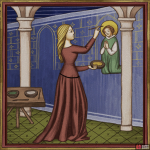Text
A large part of the population was illiterate during the Middle Ages. Therefore, art was a tool for education and communication among different layers of society. For this reason, preserved works of art are among the best sources of information about the medieval period. Wall paintings, whether sacred or profane, often reveal very detailed information about the lives of our ancestors.
While religious paintings focused primarily on spreading piety and humility towards God, secular painting represented cultural and historical moments of local history. Among the most popular motifs were allegorical scenes from the Bible, images of court life or knightly legends, and we also encounter portraits of saints (mostly patrons of the given communities) or significant clergy. The paintings also include events such as the founding of buildings, coronations of rulers, or the granting of city rights.
Figures were most often depicted in contemporary or slightly archaized clothing, even if the scenes depicted were perhaps hundreds of years old. The depicted architecture typically contains characteristic Romanesque or Gothic elements and is enriched with a number of symbolic floral and animal motifs.
Large-scale murals often came into being with the contribution of multiple artists, whose styles were visibly inspired by the works of contemporary masters of this or that region, as evidenced by similarities in themes, as well as the composition or colorfulness of the paintings.


No Comments